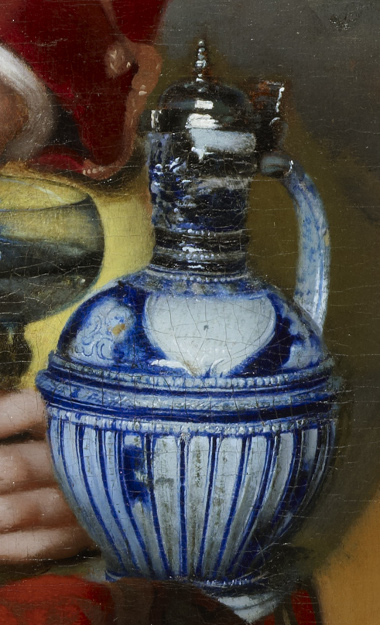Tools of the Trade
 fig. xx
fig. xx Johannes Vermeer
1656
Oil on canvas, 143 x 130 cm.
Gemäldegalerie Alte Meister, Dresden
Vermeer's early Procuress mediates between his first history paintings and the better known genre interior imagery of the artist's mature years. However, the recent restoration of this early canvas has revealed a startling use of color, previously only guessed at, that anticipates the artist's brilliant genre scenes, the Officer and Laughing Girl and Milkmaid painted a few years later.
Groups of half-length ribald figures arranged behind carpet-covered tables, known as bordeeltjes,A bordeeltje is a term derived from Dutch that refers to a specific genre of painting popular in the 17th century, particularly among artists of the Utrecht school. The word itself translates to "little brothel" in English. Bordeeltjes typically depict scenes set in brothels, featuring groups of figures, often in half-length, engaged in various activities associated with such establishments. These scenes are usually arranged behind tables covered with carpets and include characters like prostitutes, their clients, and sometimes musicians, in an interior setting. These paintings were known for their ribald and sometimes moralizing themes, highlighting the pleasures and vices of contemporary urban life. The genre was not just popular for its subject matter but also served as a means for artists to display their skill in painting textures, fabrics, and human emotions. were among the most common (and profitable) motifs of the Utrecht school. Vermeer's familiarity with this popular genre shows that the young artist was quick to adapt and renew established themes and compositions to suit his own pictorial needs. This adaptive manner of working, where he combined motifs from diverse pictorial sources, became characteristic of the painter's evolution. As the painter and art historian Lawrence Gowing first pointed out, it would be "hard to find a single theme of any boldness in his work which is not based on precedents [in the works of Vermeer]."Lawrence Gowing, Vermeer (Oakland CA: University of California Press, 1997), reprint edition, 33.
The elaborately decorated wine jug of The Procuress is true little treasure in Vermeer's oeuvre. With its light gray ground and the typical bright blue decorations (executed with pure lapis lazuli), it seems very likely that this jug had been imported from the Westerwald (Germany), a forested area near Cologne on the Rhine, famous for its pottery dating back to the sixteenth century.Westerwald pottery refers to a distinctive type of stoneware that has been produced since the early 15th century in the Westerwald region of Germany, an area rich in clay deposits. Characterized by its durability and grey-blue coloration, this pottery is renowned for its salt-glazed surface and cobalt blue decorative elements. Historically, Westerwald pottery included a wide range of items such as jugs, tankards, and crocks, often adorned with applied medallions or relief decorations featuring floral, geometric, or heraldic motifs. The combination of salt glazing—a process where salt is introduced into the kiln during firing to create a glossy, translucent surface—and the use of cobalt blue for decoration, not only made Westerwald pottery visually striking but also highly functional, as the glaze rendered the vessels waterproof and suitable for storing liquids. The distinctive style of Westerwald pottery made it a popular export item in the 17th and 18th centuries, particularly in regions such as the Netherlands and England.
In no other painting—not even the The Milkmaid—can we find an object painted with such minute precision and intensity. In fact, laboratory analysis of the picture has revealed that in order to depict the jug's contours and geometric decorations, the young Vermeer employed a pair of compasses for the purpose. Both the piercing point and the elliptical scratches initially used to define the jug's contours and blue stripes remain visible under high magnification in the paint layers. This unabashed use of a mechanical tool attests to the artist's readiness to employ any means necessary in order to heighten the mimetic quality of his work. In light of this finding, the camera obscura, evidently discovered shortly after finishing The Procuress, became an integral tool for the rest of his career, effectively an optical guide to painting—a logical extension of the painter's curiosity and creative openness.
